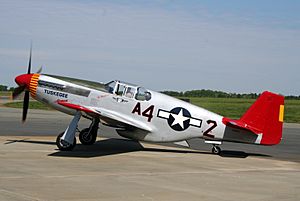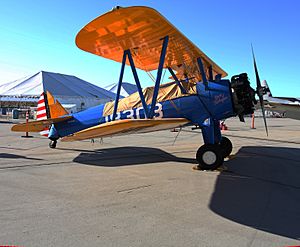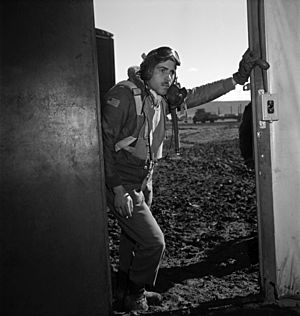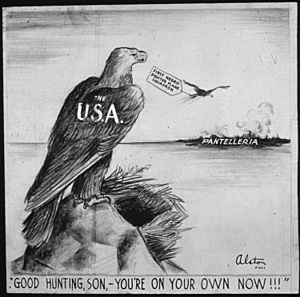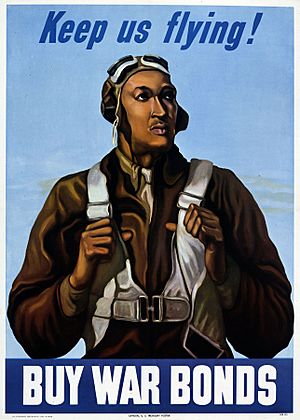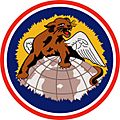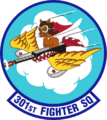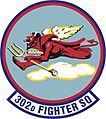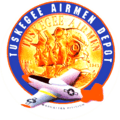Tuskegee airmen facts for kids
Quick facts for kids Tuskegee Airmen (unofficial) |
|
|---|---|
 
Emblems of wing
|
|
| Active | 1940–1948 |
| Country | United States |
| Branch | United States Army Air Corps United States Army Air Forces United States Air Force |
| Role | Trained for aerial combat |
| Part of | Graduates assigned to the 332nd Fighter Group (99th Fighter Squadron, 100th Fighter Squadron, 301st Fighter Squadron, 302d Fighter Squadron), 477th Medium Bombardment Group (616th Bombardment Squadron, 617th Bombardment Squadron, 618th Bombardment Squadron, 619th Bombardment Squadron) |
| Nickname(s) | Red Tails Red-Tail Angels |
| Motto(s) | Spit Fire |
| Engagements | World War II |
The Tuskegee Airmen were a brave group of mostly African American pilots and airmen who flew planes during World War II. At that time, many parts of the U.S. had unfair laws called Jim Crow laws that separated people based on race. The U.S. military was also separated by race.
These pilots trained in Tuskegee, Alabama, at a school called the Tuskegee Institute. They became part of two special groups: the 332d Fighter Group and the 477th Bombardment Group of the U.S. Army Air Forces.
People often called them the "Red Tails" because they painted the tails of their airplanes bright red. They were amazing pilots and earned many awards for their skill and bravery in battle.
Contents
The Story of the Tuskegee Airmen
How It All Started
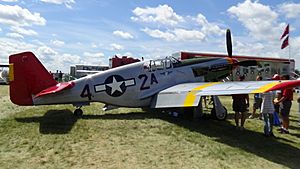
Before the Tuskegee Airmen, no African American had ever been a pilot in the U.S. military. But on April 3, 1939, a new law was passed. This law said that money should be used to train African American pilots. The War Department gave this money to schools that had Civilian Pilot Training Programs and were willing to train black Americans. The Tuskegee Institute was one of these schools.
The tests to become a pilot were very hard. They were the same tough tests that all other pilots had to pass. The U.S. Army Air Corps checked for things like IQ, how good people were with their hands, and if they could be leaders. Only the very best pilots, navigators, and bombardiers (people who aimed bombs from planes) were chosen.
When the program at Tuskegee was about five months old, the First Lady, Eleanor Roosevelt, came to visit. This was on March 29, 1941. She even flew in a plane with the African American chief instructor, C. Alfred "Chief" Anderson. After they landed, she happily said, "Well, you can fly all right."
Tuskegee Airmen in Action
The 99th Pursuit Squadron was created in 1941. It was later renamed the 99th Fighter Squadron in May 1942. These pilots trained hard for their missions. They were part of the 332nd Fighter Group, which also included the 100th, 301st, and 302nd Fighter Squadrons.
By April 1943, the 99th Fighter Squadron was ready for combat. Their first combat mission was on June 2, 1943. They helped prepare for the Allied invasion of Sicily. By February 1944, the other squadrons (100th, 301st, and 302nd) had joined them. The 332nd Fighter Group flew missions in places like Sicily, Anzio, and Normandy. Their jobs included protecting bomber planes and attacking enemy planes, trains, and ships.
The pilots of the 99th once shot down five enemy planes in less than four minutes! The pilots of the 332nd Fighter Group earned 96 Distinguished Flying Crosses for their bravery.
Another group, the 477th Bombardment Group, was training in the U.S. They were a B-25 bomber group. However, they did not finish their training in time to fight overseas before the war ended.
Amazing Achievements in War
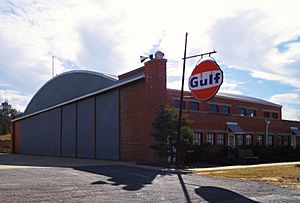
From 1941 to 1946, 992 pilots were trained in Tuskegee. About 355 of them went overseas to fight. Sadly, 84 of them lost their lives. This included 68 pilots who died in combat or accidents. Twelve died during training, and 32 were captured as prisoners of war.
The Tuskegee Airmen were praised for these achievements:
- They flew 1,578 combat missions.
- They flew 179 missions protecting bomber planes. They were very good at keeping the bombers safe.
- They destroyed 112 enemy aircraft in the air. They also destroyed 150 on the ground and damaged 148 more.
- They destroyed 950 rail cars, trucks, and other vehicles. Over 600 of these were rail cars.
- They put one enemy torpedo boat out of action.
- They destroyed 40 enemy boats and barges.
They also received many awards and honors:
- Three Distinguished Unit Citations
- At least one Silver Star
- 96 Distinguished Flying Crosses were given to 95 Airmen. Captain William A. Campbell received two.
- 14 Bronze Stars
- 744 Air Medals
- At least 60 Purple Hearts
After the War
In 1948, President Harry S. Truman ended racial separation in the military. This was done with Executive Order 9981. After this, the Tuskegee Airmen were highly wanted in the new United States Air Force. Some became teachers in civilian flight schools. Others were promoted to higher ranks in the military.
In 1949, the 332nd Fighter Group entered a gunnery competition in Las Vegas, Nevada. They had to shoot at targets in the air and on the ground. They also dropped bombs on targets. They won first place by getting a perfect score!
In August 2019, 14 of the original Tuskegee Airmen attended their yearly convention. Many of these brave airmen have lived to be 90 or even over 100 years old.
Lasting Impact and Honors
On March 29, 2007, President George W. Bush gave the Tuskegee Airmen a Congressional Gold Medal. This special ceremony happened in the U.S. Capitol rotunda. The medal is now on display at the Smithsonian Institution.
The airmen continued to do great things after the war. One became a judge. Four were promoted to generals. Others became successful business people and politicians.
The airfield where the airmen trained is now a special place called the Tuskegee Airmen National Historic Site. Many memorials and museums across the country honor the Tuskegee Airmen.
A part of State Route 6 in East Point, Georgia, was officially renamed to honor the Tuskegee Airmen. This road is one of the main ways to get to Hartsfield-Jackson International Airport.
In Movies and Books
The story of the Tuskegee Airmen has been told in many ways. There are paintings, murals, novels, movies, documentaries, plays, radio shows, and even toys that feature them.
Fun Facts About the Tuskegee Airmen
- Many people thought the "Tuskegee Experiment" would fail, but it was a huge success!
- On January 27 and 28, 1944, they shot down 13 enemy airplanes. This happened while they were protecting Allied ground forces.
- The 332nd Fighter Group and its four squadrons shot down a total of 112 enemy airplanes during their time overseas.
- Benjamin Davis became the first black general in the United States Air Force.
- Colonel Charles McGee served with the 332nd Fighter Group. He also fought in Korea and Vietnam. He flew 409 combat missions, which is more than any other Air Force pilot in those three wars.
- C. Alfred "Chief" Anderson got his pilot's license in 1929. He was the first black American to get a commercial pilot's certificate in 1932.
- No one called them the "Tuskegee Airmen" during World War II. This nickname was created by author Charles E. Francis in his 1955 book, The Tuskegee Airmen: The Men Who Changed a Nation.
Images for kids
-
A tail signed by surviving Tuskegee Airmen at the Palm Springs Air Museum.
-
Congressman Christopher Smith presented the Purple Heart Medal to Tuskegee Airman Tech. Sgt. (Ret.) George Watson Sr. in 2010.
-
The restored P-51 Mustang flown by the Red Tail Project.
-
An General Dynamics F-16 Fighting Falcon on display at the Aviation Challenge. It honors the Tuskegee Airmen.
See Also
 In Spanish: Aviadores de Tuskegee para niños
In Spanish: Aviadores de Tuskegee para niños
- 92nd Infantry Division
- 93rd Infantry Division
- 555th Parachute Infantry Battalion "Triple Nickle"
- 761st Tank Battalion
- Bessie Coleman – the first African-American female pilot.
- Fly (a 2009 play about the Tuskegee Airmen)
- List of African-American Medal of Honor recipients
- List of Tuskegee Airmen
- List of Tuskegee Airmen Cadet Pilot Graduation Classes, 1942–1946
- Military history of African Americans
- Racial discrimination against African Americans in the U.S. Military
- Red Ball Express
- Strategic bombing during World War II
- Port Chicago disaster
- Walterboro Army Airfield training site and memorial
- Willa Brown


